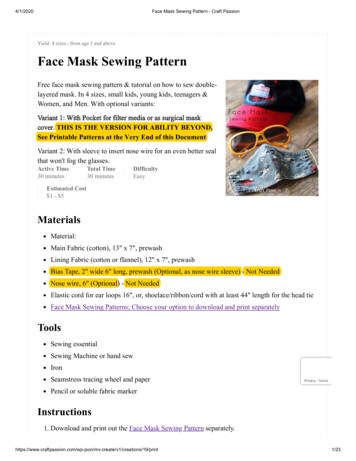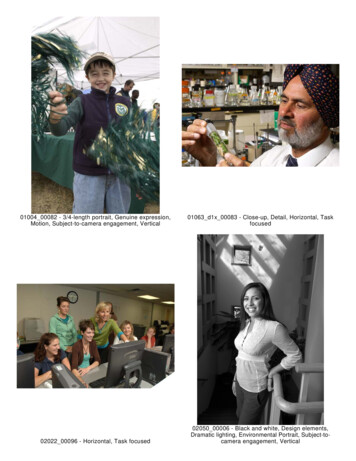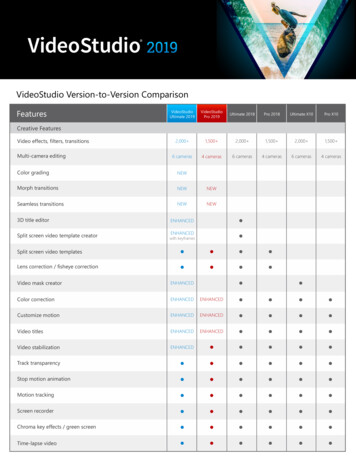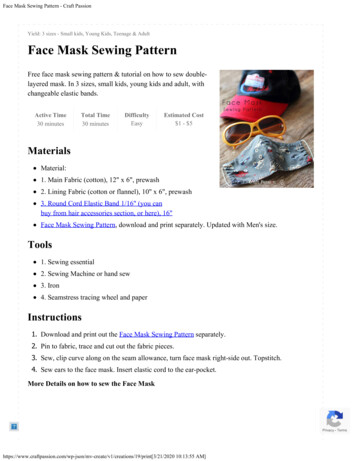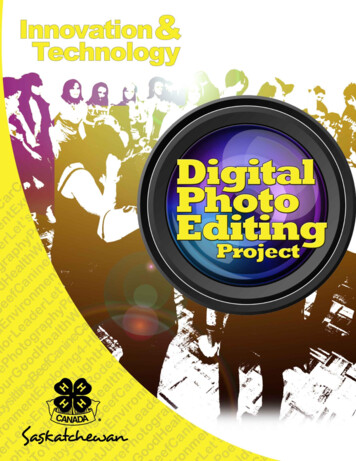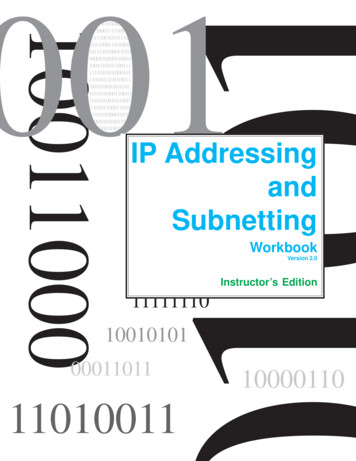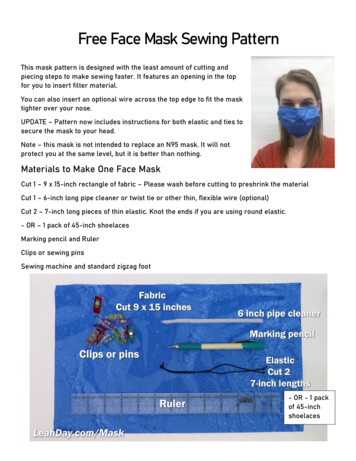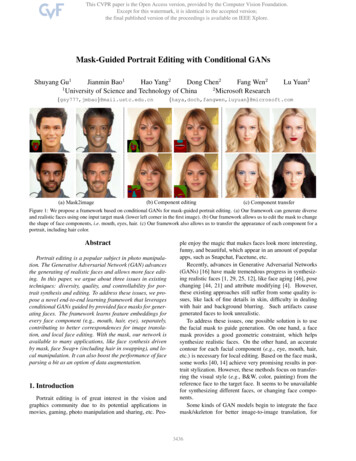
Transcription
Mask-Guided Portrait Editing with Conditional GANsShuyang Gu1Jianmin Bao1Hao Yang2Dong Chen2Fang Wen212University of Science and Technology of ChinaMicrosoft Research{gsy777,jmbao}@mail.ustc.edu.cnLu Yuan2{haya,doch,fangwen,luyuan}@microsoft.com(b) Component editing(a) Mask2image(c) Component transferFigure 1: We propose a framework based on conditional GANs for mask-guided portrait editing. (a) Our framework can generate diverseand realistic faces using one input target mask (lower left corner in the first image). (b) Our framework allows us to edit the mask to changethe shape of face components, i.e. mouth, eyes, hair. (c) Our framework also allows us to transfer the appearance of each component for aportrait, including hair color.AbstractPortrait editing is a popular subject in photo manipulation. The Generative Adversarial Network (GAN) advancesthe generating of realistic faces and allows more face editing. In this paper, we argue about three issues in existingtechniques: diversity, quality, and controllability for portrait synthesis and editing. To address these issues, we propose a novel end-to-end learning framework that leveragesconditional GANs guided by provided face masks for generating faces. The framework learns feature embeddings forevery face component (e.g., mouth, hair, eye), separately,contributing to better correspondences for image translation, and local face editing. With the mask, our network isavailable to many applications, like face synthesis drivenby mask, face Swap (including hair in swapping), and local manipulation. It can also boost the performance of faceparsing a bit as an option of data augmentation.1. IntroductionPortrait editing is of great interest in the vision andgraphics community due to its potential applications inmovies, gaming, photo manipulation and sharing, etc. Peo-ple enjoy the magic that makes faces look more interesting,funny, and beautiful, which appear in an amount of popularapps, such as Snapchat, Facetune, etc.Recently, advances in Generative Adversarial Networks(GANs) [16] have made tremendous progress in synthesizing realistic faces [1, 29, 25, 12], like face aging [46], posechanging [44, 21] and attribute modifying [4]. However,these existing approaches still suffer from some quality issues, like lack of fine details in skin, difficulty in dealingwith hair and background blurring. Such artifacts causegenerated faces to look unrealistic.To address these issues, one possible solution is to usethe facial mask to guide generation. On one hand, a facemask provides a good geometric constraint, which helpssynthesize realistic faces. On the other hand, an accuratecontour for each facial component (e.g., eye, mouth, hair,etc.) is necessary for local editing. Based on the face mask,some works [40, 14] achieve very promising results in portrait stylization. However, these methods focus on transferring the visual style (e.g., B&W, color, painting) from thereference face to the target face. It seems to be unavailablefor synthesizing different faces, or changing face components.Some kinds of GAN models begin to integrate the facemask/skeleton for better image-to-image translation, for3436
example, pix2pix [24], pix2pixHD [45], where the facialskeleton plays an important role in producing realistic facesand enabling further editing. However, the diversity of theirsynthesized faces are so limited, for example, the input andoutput pairs might not allow noticeable changes in emotion. The quality issue especially on hair and backgroundprevents resulting images from being realistic. The recentwork BicycleGAN [48] tries to generate diverse faces fromone input mask, but the diversity is limited on color or illumination.We have to reinvestigate and carefully design the imageto-image translation model, which addresses the three problems – diversity, quality, and controllability. Diversity requires the learning of good correspondences between imagepairs, which may undergo variance in poses, lightings, colors, ages and genders, for image translation. Quality shouldfurther improve in fine facial details, hair, and background.More controls for local facial components are also key.In this paper, we propose a framework based on conditional GANs [33] for portrait editing guided by face masks.The framework consists of three major components: local embedding sub-network, mask-guided generative subnetwork, and background fusion sub-network. The threesub-networks are trained end-to-end. The local embeddingsub-network involves five auto-encoder networks which respectively encode embedding information for five facialcomponents, i.e., “left eye”, “right eye”, “mouth”, “skin &nose”, and “hair”. The face mask is used to help specify theregion for each component in learning. The mask-guidedgenerative sub-network recombines the pieces of local embeddings and the target face mask together, yielding theforeground face image. The face mask helps establish correspondences at the component level (e.g., mouth-to-mouth,hair-to-hair, etc.) between the source and target images.At the end, the background fusing sub-network fuses thebackground and the foreground face to generate a naturalface image, according to the target face mask. For guidance, the face mask aids facial generation in all of threesub-networks.With the mask, our framework allows many applications.As shown in Figure 1 (a), we can generate new faces drivenby the face mask, i.e., mask-to-face, as well as skeletonto-face in [24, 45]. We also allow more editing, such asremoving hairs, amplifying or reducing eyes, and making itsmile, as shown in Figure 1 (b). Moreover, we can modifythe appearance of existing faces locally, such as the changing appearance of each facial component, shown in Figure 1(c). Experiments shows that our methods outperform stateof-the-art face synthesis driven by a mask (or skeleton) interms of diversity and quality. More interesting, our framework can help boost the performance of face parsing algorithm marginally as the data augmentation.Overall, our contributions are as follows:1. We propose a novel framework based on mask-guidedconditional GANs, which successfully addresses diversity, quality and controllability issues in face synthesis.2. The framework is general and available for an amountof applications, such as mask-to-face synthesis, faceediting, face swap , and even data augmentation forface parsing.2. Related WorkGenerative Adversarial Networks Generative adversarial networks (GANs) [16] have achieved impressive resultsin many directions. It forces the generated samples to beindistinguishable from the target distribution by introducing an adversarial discriminator. The GAN family enablesa wide variety of computer vision applications such as image synthesis [2, 36], image translation [24, 47, 45, 48], andrepresentation disentangling [22, 4, 44], among others.Inspired by the conditional GAN models [33] that generate images from masks, we propose a novel framework formask-guided portrait editing. Our method leverages localembedding information for individual facial components,generating portrait images with higher diversity and controllability, than existing global-based approaches such aspix2pix [24] or pix2pixHD [45].Deep Visual Manipulation Image editing has benefiteda lot from the rapid growth of deep neural networks, including image completion [23], super-resolution [28], deepanalogy [30], and sketch-based portrait editing [39, 34], toname a few. Among them, the most related are mask-guidedimage editing methods, which train deep neural networks totranslate masks into realistic images [11, 8, 24, 45, 47].Our approach also relates to the visual attribute transfermethods, including style transfer [15, 17] and color transfer [19]. Recently, the Paired-CycleGAN [9] has been proposed for makeup transfer, in which a makeup transfer function and a makeup removal function are trained in pair.Though similar, the appearances of facial instances that ourmethod disentangles differ from makeups. For example, thecolor and curly types of hairs which we can transfer are definitely not makeups. Furthermore, there are some works focusing on editing a specific component in faces (e.g., eyes[13, 41]) or editing attributes of faces [35, 42].With the proposed structure that disentangles and recombines facial instance embeddings with face masks, ourmethod also enhances over face swapping methods [5, 26]by supporting explicit face and hair swapping.Non-Parametric Visual Manipulation Non-parametricimage synthesis approaches [18, 6, 27] usually generatenew images by warping and stitching together existingpatches from a database. The idea is extended by Qi et3437
al. [37] which combines neural networks to improve quality. Though similar at first glance, our method is intrinsically different from non-parametric image synthesis: ourlocal embedding sub-network encodes facial instances asembeddings instead of image patches. New face images inour method are generated through the mask-guided generative sub-network, instead of warping and stitching imagepatches together. By jointly training all sub-networks, ourmodel generates facial images that are higher quality thannon-parametric methods that may also be difficult for them:e.g. synthesizing a face with an open mouth showing teethfrom a source face with a closed mouth hiding all teeth.3. Mask-Guided Portrait Editing FrameworkWe propose a framework based on conditional GANs formask-guided portrait editing. Our framework requires fourinputs, a source image xs , the mask of source image ms ,a target image xt , and the mask of target image mt . Themask ms and mt can be obtained by a face parsing network. If we want to change the mask, we can manuallyedit mt . With the source mask xs , we cannot get the appearance of each face component, e.g., “left eye”, “righteye”, “mouth”, “skin & nose”, and “hair” from the sourceimage. With the target mask mt , we can get the background from the target image xt . Our framework first recombines the appearance of each component from xs andthe target mask together, yielding the foreground face, thenfusing it with the background from xt , outputting the finalresult G(xs , ms , xt , mt ). G indicates the overall generative framework.As shown in Figure 2, we first use a local embeddingsub-network to learn feature embedding for the input sourceimage xs . It involves five auto-encoder networks to encodeembedding information for five facial components respectively. Comparing with [45, 48] which learn global embedding information, our approach can retain more source facial details. The mask guided generative sub-network thenspecifies the region of each embedded component featureand concatenates all features of the five local componentstogether with the target mask to generate the foregroundface. Finally, we use the background fusing sub-networkto fuse the foreground face and the background to generatea natural facial image.3.1. Framework ArchitectureLocal Embedding Sub-Network. To enable componentlevel controllability of our framework, we propose learningfeature embeddings for each component in the face. Wefirst use a face parsing network PF (details in Section 3.2)which is a Fully Convolution Network (FCN) trained onthe Helen dataset [43] to get the source mask ms of thesource image xs . Then, according to the face mask, wesegment the foreground face image into five componentsxsi , i {0, 1, 2, 3, 4}, i.e., “left eye”, “right eye”, “mouth”,“skin & nose”, and “hair”. For each facial component,iwe use the corresponding auto-encoder network {Elocal,iGlocal }, i {0, 1, 2, 3, 4}, to embed its component information. With five auto-encoder networks, we can conveniently change any one of facial components in the generated face images or recombine different components fromdifferent faces.Previous works, e.g., pix2pixHD [45], also train an autoencoder network to get the feature vector that correspondswith each instance in the image. To guarantee the featuresthat fit different instance shape, they add an instance-wiseaverage pooling layer to the output of the encoder to compute the average feature for the object instance. Althoughthis approach allows object-level control on the generatedresults, their generated faces still suffer from low qualityfor two reasons. First, they use a global encoder network tolearn feature embeddings for different instances in the image. We argue that merely a global network is quite limitedin learning and recovering all local details of each instance.Second, the instance-wise average pooling would removemany characteristic details in reconstruction.Mask-Guided Generative Sub-Network. To make thetarget mask mt a guidance for mask equivariant facial generation, we adopt an intuitive way to fuse the five component feature tensors and the mask feature tensor together.As shown in Figure 2 (b), five component feature tensorsare extracted by the local embedding sub-network, and themask feature tensor is the output of the encoder Em .First, we get the center location {ci }i 1.5 of each component from the target mask xt . Then we prepare five 3Dtensors all filled with 0, i.e., {fˆi }i 1.5 . Every tensor hasthe same height and width with the mask feature tensor, andthe same channel number with each component feature tensor. Next, we copy each of the five learned component feature tensors to all-zero tensor fˆi centered at ci according tothe target mask (e.g., mouth-to-mouth, eye-to-eye etc.). After that, we concatenate all 3D and mask feature tensors toproduce a fused feature tensor. Finally, we feed the fusedfeature tensor to the network Gm and produce the foreground face image.Background Fusing Sub-Network. To paste the generated foreground faces to the background of the target image, the straightforward approach is to copy the backgroundfrom the target image xt and combine it with the foreground faces according to the target face mask. However,this causes noticeable boundary artifacts in the final results.There are two possible reasons. First, the background contains neck skin parts, so the unmatched face skin color in thesource face xs and the neck skin color in the target imagext cause the artifacts. Second, the segmentation mask forthe hair part is not always perfect, so the hair in the back-3438
Local Embedding Sub-NetworkSource mask 𝒎𝒎𝒔𝒔Source image ��𝑙𝑙𝑙Mask-Guided Generative Sub-NetworkTarget mask 𝒎𝒎𝒕𝒕Target image 𝒙𝒙𝒕𝒕Background Fusing Sub-NetworkResult 𝐺𝐺(𝒙𝒙𝒔𝒔 , 𝒎𝒎𝒔𝒔 , 𝒙𝒙𝒕𝒕 , 𝒎𝒎𝒕𝒕 �𝐺Figure 2: The proposed framework for mask-guided portrait editing. It contains three parts: local embedding sub-network, mask guidedgenerative sub-network, and background fusing sub-network. Local embedding sub-network learns the feature embedding of the localcomponents of the source image. Mask guided sub-network combines the learned component feature embeddings and mask to generate theforeground face image. Background fusing sub-network generates the final result from the foreground face and the background. The lossfunctions are drawn with the blue dashed lines.ground also causes artifacts.To solve this problem, we propose using the backgroundfusing sub-network to remove the artifacts in fusion. Wefirst use the face parsing network PF (details in Section 3.2)to get the target face mask xt . According to the face mask,we extract the background part from the target image, andthen feed the background part to an encoder Eb to obtainthe output background feature tensor. After that, we concatenate the background feature tensor with the foregroundface, and feed it to the generative network Gb producingfacial result G(xs , ms , xt , mt ).3.2. Loss FunctionsLocal Reconstruction. We use the MSE loss between theinput instances and the reconstructed instances to learn thefeature embedding of each instance.1 si x Gilocal (Elocal(xsi )) 22 ,(1)2 iswhere xi , i {0, 1, 2, 3, 4} represents “left eye”, “righteye”, “mouth”, “skin & nose”, and “hair” in xs .Llocal Global Reconstruction. We consider the reconstructionerror in training. When the input source images xs isthe same as the target image xt , the generated resultG(xs , xs , xt , mt ) should be the same as xs . Based on theconstraint, the reconstruction loss can be measured by:Lglobal 1 G(xs , ms , xt , mt ) xs 222(2)Adversarial Loss. To produce realistic results, we adddiscriminator networks D after the framework. Similar toGAN, the overall framework G plays a minimax game withdiscriminator network D. Since a simple discriminator network D is not suitable for face image synthesis with resolution 256 256. Following the method in pix2pixHD [45],we also use multi-scale discriminators. We use 2 discriminators that have an identity network structure but operateat different image scales. we downsample the real and generated samples by a factor of 2 using the average poolinglayer. Moreover, the generated samples should be conditioned on the target mask mt . So the loss function for thediscriminators Di , i 1, 2 is:3439
LDi Ext Pr [logDi (xt , mt )] Ext ,xs Pr [log(1 Di (G(xs , ms , xt , mt ), mt )],(3)and the loss function for the framework G is:Lsigmoid Ext ,xs Pr [log(Di (G(xs , ms , xt , mt ), mt )].(4)The original loss function for G may cause unstable gradient problems. Inspired by [3, 45], we also use a pairwisefeature matching objective for the generator. To generaterealistic face images quality, we match the features of thenetwork D between real and fake images. Let fDi (x, mt )denote features on an intermediate layer of the discriminator, then the pairwise feature matching loss is the Euclideandistance between the feature representations, i.e.,LF M 1 fDi (G(xs , ms , xt , mt ), mt ) fDi (xt , mt ) 22 ,2(5)where we use the last output layer of network Di as thefeature fDi for our experiments.The overall loss from the discriminator networks to theframework G is:LGD Lsigmoid λF M LF M .(6)where λF M controls the importance of the two terms.Face Parsing Loss. In order to generate mask equivariant facial images, we need to make the generated sampleshave the same mask as the target mask, and a face paringnetwork PF to constrain the generated faces, following previous methods [32, 38]. We pretrain the face parsing network PF with a U-Net network structure on the Helen FaceDataset [43]. The loss function LP for network PF is thepixel-wise cross entropy loss, This loss examines each pixelindividually, comparing the class predictions (depth-wisepixel vector) to our one-hotXencoded target vector pi,j :LP Ex Pr [log P (pi,j PF (x)i,j )].(7)i,jHere, the (i, j) indicates the location of the pixel.After we get the pretrained network PF . we use PF toencourage the generated samples to have the same maskwith the target mask, so we use the following loss functionfor the generative network:LGP Ex Pr [Xlog P (mti,j PF (G(xs , ms , xt , mt ))i,j )],i,j(8)where mti,j is the ground truth label of xt located at (i, j).PF (G(xs , ms , xt , mt ))i,j is the predict pixel located at(i, j).Overall Loss Functions. The final loss for G is a sum ofthe above losses in Equation 1, 2, 6, 8.LG λlocal Llocal λglobal Lglobal λGD LGD λGP LGP ,(9)where λlocal , λglobal , λGD , and λGP are the trade-offs balancing different losses. In our experiments, λlocal , λglobal ,λGD , and λGP are set as {10, 1, 1, 1} respectively.source image target mask/imagesetting 1setting 2oursFigure 3: Visual comparison of our proposed framework and itsvariants.3.3. Training StrategyDuring training, the input masks ms , mt always use theparsing results of source image xs and target image xt . Weconsider two situations in training: 1) xs and xt are thesame, which is called paired data, 2) xs and xt are different, which is called unpaired data. Inspired by [4] , we incorporate these settings into the training stage, and employa (1 1) strategy, one step for paired data training and theother step for unpaired data training. However, the trainingloss functions for these two settings should be different. Forpaired data, we use all losses in LG , but for unpaired data,we set λglobal and λF M to zero in LG .4. ExperimentsIn this section, we validate the effectiveness of theproposed method. We evaluate our model on the HelenDataset[43]. The Helen Dataset contains 2, 330 face images(2, 000 for training and 330 for testing) with the pixel-levelmask label annotated. But 2, 000 facial images have limiteddiversity, so we first use these 2, 000 face images to traina face parsing network, and use the parsing network to getsemantic masks for an additional 20, 000 face images fromVGGFace2 [7]. We use a total of 22, 000 face images fortraining during experiments . For all training faces, we firstdetect the facial region with the JDA face detector [10], andthen locate five facial landmarks (two eyes, nose tip and twomouth corners). After that, we use similarity transformationbased on the facial landmarks to align faces to a canonicalposition. Finally, we crop a 256 256 facial region to dothe experiments.In our experiments, the input size of five instances (lefteye, right eye, mouth, skin, and hair) are decided by themax size of each component. Specially, we use 48 32,48 32, 144 80, 256 256, 256 256 for left eye, righteye, mouth, skin, and hair in our experiments. For networkdetails of Elocal , Glocal , Em , Gm , Eb , and Gb and trainingsettings, please refer to the supplementary material.3440
bicycleGANpix2pixHDtarget imageourstarget maskFigure 4: Comparison of mask to face synthesis results withpix2pixHD [45] and BicycleGAN[48], The target mask and thetarget face image are on the left side. The first and second rowsare the generated results from pix2pixHD and BicyleGAN respectively. The diversity of the generated samples are mainly from theskin color or illumination. The third row is the generated resultsfrom our methods. We can generate more realistic and diverse facial images.4.1. Analysis of the Proposed FrameworkOur framework is designed to solve three problems –diversity, quality, and controllability in mask-guided facialsynthesis. To validate this, we perform a step by step ablation study to understand how our proposed framework helpssolve these three problems.We perform three gradually changed settings to validateour framework: 1) We train a framework using a globalauto-encoder to learn the global embedding of the sourceimage, then we concatenate the global embedding with thetarget mask to generate the foreground face image withlosses Lglobal , LGP , and LGD . We then crop the background from the target image and directly paste it to the generated foreground face to get the result. 2) We train anotherframework using a local embedding sub-network to learnthe embedding of each component of the source image, thenwe concatenate the local embedding with the target mask togenerate the foreground face. After that, we get the background using the same method as 1). 3) We train our framework taking full advantage of local embedding sub-network,mask-guided generative sub-network, and background fusing sub-network to get the final results.Figure 3 presents qualitative results for the above threesettings. Comparing settings 2 and 1, we see that using alocal embedding sub-network helps the generated resultsto keep the details (e.g. eye’s size, skin color, hair color)from the source images. This enables the controllability ofour framework to control each component of the generatedface. By feeding different components to the local embedding sub-network, we can generate diverse results, whichshows our framework handles the diversity problem. Comparing these two variant settings with our method, a back-Table 1: Quantitative comparison of our framework and its variants, setting 1,2 are defined in Section 4.1.Setting12oursFID11.02 11.26 8.92Table 2: Comparison of face parsing results with and without usingface parsing networks.Methodw/o face parsing networksw face parsing networksavg. per-pixel accuracy0.9460.977ground copied directly from the target image causes noticeable boundary artifacts. In our framework, the backgroundfusing sub-network helps to remove the artifacts and generate more realistic faces, proving that our framework cangenerate high quality faces.To quantitatively evaluate each setting, we generate5, 000 facial images for each setting, and calculate theFID [20] between the generated faces and the training faces.In Table 1, we report the FID for each setting. The local embedding sub-network and background fusing sub-networkhelp improve the quality of generated samples. Meanwhile,the low FID score indicates that our model can generatehigh-quality faces from masks.To validate whether our face parsing loss helps keep themask of the generated samples, we conduct an experimentto validate this. We train another framework without using the face parsing loss. Then we generate 5, 000 samplesfrom this framework. Next, we use another set of face parsing networks to get the average per-pixel accuracy with thetarget mask as ground truth for all generated faces. Table 2reports the results, showing that the face parsing loss helpsto preserve the mask of the generated faces.4.2. Mask-to-Face SynthesisThis section presents the results of mask to face synthesis. The goal of mask to face synthesis is to generate realistic, diverse and mask equivariant facial images from agiven target mask. To demonstrate that our framework hasthe ability to generate realistic and diverse faces from aninput mask, we choose some masks and randomly choosesome facial images as the source image and synthesize thefacial images.Figure 5 presents the face synthesis results from the input masks. The first column is the target masks, and the faceimages on the right side are the generated face images conditioned on the target masks. We observe that the generatedface images are photo-realistic. Meanwhile, the generatedfacial images perform well in terms of diversity, such as inskin color, hair color, eye makeup, and even beard. Furthermore, the generated facial images also maintain the mask.Previous methods also try to do the mask-to-face synthesis, BicycleGAN [48] is an image-to-image translationmodel which can generate continuous and multimodal out-3441
Figure 5: Our framework can synthesize realistic, diverse and mask equivariant faces from one target mask.put distributions. pix2pixHD allows high resolution imageto-image translation. In Figure 4, we show the qualitativecomparison results. We observe that the generated samplesby BicycleGAN and pix2pixHD show a limited diversity,and the diversity lies in the skin color or illumination. Thereason for this is that they use a global encoder, so the generated samples cannot leverage the diversity of componentsin the faces. In contrast, the generated results by our methods look realistic, clear and diverse. Our model is also ableto keep the mask information. It shows the strength of theproposed framework.4.3. Face Editing and Face Swap Another important application for our framework is facial editing. With the changeable target mask and sourceimage, we can edit on the generated face images by editingthe target mask or replacing the facial component from thesource image. We conduct two experiments: 1) changingthe target mask to change the appearance of the generatedfaces; 2) replacing the facial component of the target imagewith new component from other’s faces to explicitly changethe corresponding component of the generated faces.Figure 6 shows the generated results of changing the target mask. We replace the label of hair region on foreheadwith skin label, and we get a vivid face images with no hairon the forehead. Besides that, we can change the shape ofthe mouth, eyes, eyebrows region in the mask, and get anoutput facial image even with new emotions. This showsthe effectiveness of our model in generating mask equivariant and realistic results.Figure 7 shows the results of changing individual partsof the generated face. We can add the beards to the generated face by replacing the target skin part with the skin partof a face with a beard. We also change the mouth color, haircolor, and even the eye makeup by changing the local embedding part. This shows the effectiveness of our model inFigure 6: Our framework allows users to change mask labels locally to explicitly manipulate facial components, like making shorthair become longer, and even changing the emotion.generating local instance equivariant and realistic results.Figure 8 shows the results of face swap . Differentfrom traditional face swap algorithm, our framework cannot only swap the face appearance but also keep the component shape. More importantly, we can explicitly swap thehair part compared to previous methods.Furthermore, Figure 9 shows more results for input faceunder extreme conditions. In the first two rows, the input3442
Figure 9: The generated results with input faces under extreme conditions (large pose, extreme illumination and face withglasses).Table 3: Results of face parsing with added generated facial images.HelenHelen (with data augmentation)Helen generated (with data augmentation)Figure 7: We can also edit the appearance of instances in the face,e.g. adding beards and changing the color of mouth, hair, and eyemakeup.Figure 8: Our framework can enhance an existing facial swap,called face swap , to explicitly swap the hair.face images have large poses and extreme illumination. Ourmethod gets reasonable and realistic results. Also, if the input face has eye-glasses, we find that the result relies onthe segmentation mask. If the glasses are labeled as background, it can be reconstructed by our background fusionsub-network, the generated result is shown in the last row.4.4. Synthesized Faces for Face ParsingWe further show that the facial images synthesized fromour framework can benefit the trai
mask provides a good geometric constraint, which helps synthesize realistic faces. On the other hand, an accurate contour for each facial component (e.g., eye, mouth, hair, etc.) is necessary for local editing. Based on the face mask, some works [40, 14] achieve very promising results in por-trait stylization. However, these methods focus on .
